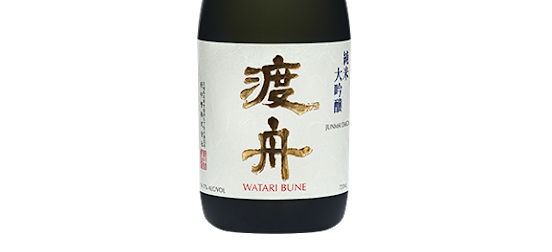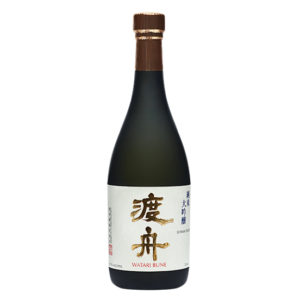The Apex of Ibaraki ginjo-shu from Huchu Homare
At a Glance: Heirloom-strain Watari Bune rice highlights this deeply fruity-floral sake. Watari Bune Junmai Daiginjo is remarkably versatile with food pairings.
Watari Bune 渡舟 Junmai Daiginjo sits at the top of the Tokutei meisho-shu (特定名称酒) quality scale, and along with Sudo Honke’s “Kakunko” Junmai Daiginjo, represents the apex of Ibaraki ginjo-shu. This sake is at times labeled “Ferry Boat” and “Liquid Gold” for export markets.
Whatever you want to call Watari Bune– it brings big aromatics, big fruit, an exotic profile, and a solid structure. The texture is soft and expansive, with enough brightness to be refreshingly food-friendly. Like its excellent Junmai Ginjo cousin, Watari Bune Junmai Daiginjo is pasteurized only once in-bottle (namachozo) and unfiltered (muroka), giving provides a little extra intensity, vibrancy, and acidity.
A Namazake version of this sake exists, albeit in tiny supply.
Pairing/ Service
Watari Bune Junmai Daiginjo is very good with ankimo, uni, oysters, ebi, kani, nigiri, sashimi, and maki. It’s also good with hamachi kama shioyaki, saba shioyaki, and chawanmushi.
This Junmai Daiginjo, like Watari Bune 55, shows best in a white wine glass. This highlights the aromatics and the wonderful structure. O-choko will tone-down the intensity and elevate the fruit. Guinomi are a nice middle ground with an authentic feel.
Tech & Production Info
SMV: +3 Acid: 1.4 Amino Acid: 1.0
Rice: Wataribune milled to 35% Yeast: #9
Junmai Daiginjo Namachozo Muroka
Shubo: Sokujo gentle fune press Aged: 3-10 mo. in tank
the Huchu Homare Brewery
Brewery: Huchu Homare Shuzo 府中誉 “Pride of Huchu” Location: Ishioka, Ibaraki
EST: 1854 Official Site US Importer– Joto Sake
Huchu Homare (“Pride of Huchu”) is a well-respected brewery from Ibaraki. They were “mentored” by Sudo Honke to a degree, but today, are thoroughly their equal. The brewery’s “Huchu Rokui” spring water is medium-soft in hardness. Produces about 12K cases (12 bottles 720ml, 6 bottles 1800ml) annually. Style: “abundant but balanced fruitiness offset by light nuttiness and earthiness”. Their sake available in the US are typically Namachozo.
Huchu Homare famously revived the heirloom Watari Bune sakamai, and now makes several sake using the characterful grain. They work with several local farmers to grow the fickle rice– about 4ha in all. The brewery mills their rice in-house. This extra step means better control over the process and better results during fermentation.
With a lot of fertile soil, Ibaraki is dominated by agriculture. Ibaraki buckwheat (soba) is considered some of the best in Japan. Persimmon, grapes, pears, and rice are also major crops. The coast of Ibaraki is famous for monkfish (ankou)– in particular the liver (ankimo), and as ankou-nabe (stew). Using the indigenous Watari Bune grain, Huchu Homare’s sake is well-suited to pairing with these regional dishes. Huchu Homare also recommends Watari Bune with foie gras, pate, risotto, lamb, and pork.
informative Japan Times article a solid Urban Sake report
Label / Kanji
Watari Bune 渡舟 Huchu Homare 府中誉
Junmai Daiginjo 純米大吟
Namachozo 生貯藏 Muroka 無濾過
Ibaraki-ken 茨城県
Follow the Japanese Bar on Social Media
Connect with our latest posts, the newest Japanese beverage info, and get exclusive promotional offers. Level-up your sake IQ!

